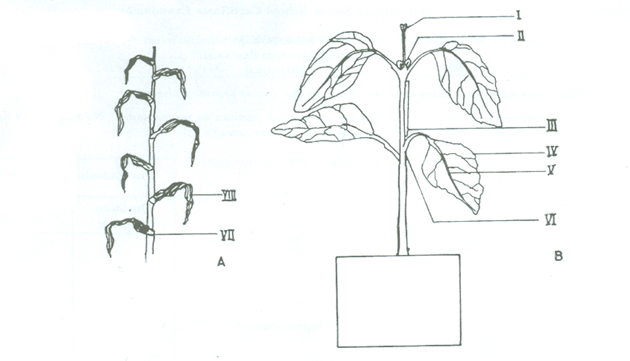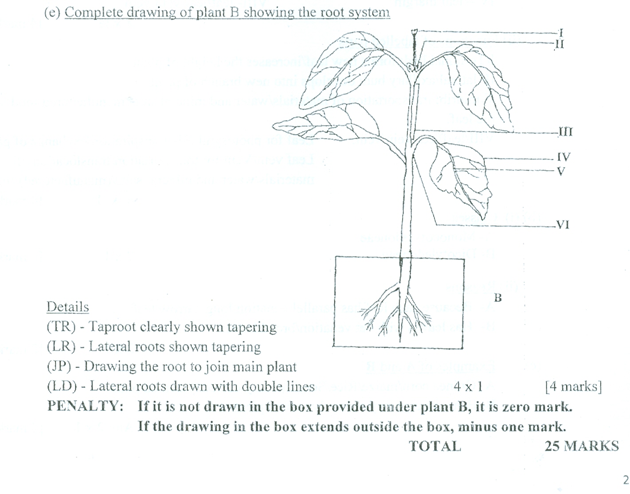Question 1
- Diagrams A and B below illustrate portions of two different young plants. Study them carefully and answer questions 1(a) to (e).

(a) (i) Name the parts labelled I to VIII.
I. ……………………………….. V. …………………………..
II. ……………………………….. VI. …………………............
III. ……………………………….. VII. ……………………………
IV. ……………………………… VIII. ………………………........
[4 marks]
(ii) State one function each of the parts labelled I, II, V and VIII.
- I ……………………………………………………………………………...
- II ……………………………………………………………………………..
- V ……………………………………………………………………………..
- VIII……………………………………………………………………………..[4 marks]
- …………………………………………………
- ………………………………………………..
- ……………………………………………….
- ……………………………………………….
- ……………………………………………….
(b) (i) Name the class to which each of the plants belongs.
A …………………………………………………………………
B ………………………………………………………………… [2 marks]
(ii) State one reason each for the answers in b (i).
A ………………………………………………………………….
B …………………………………………………………………. [2 marks]
(c) State one example each of a plant belonging to the classes listed in (b) (i).
A …………………………………………………………….
B …………………………………………………………….[4 marks]
(d) (i) In a tabular form, state five observable differences between plants A and B.
A B
………………………………………. |
[5 marks]
(ii) State two similarities between plants A and B.
………………………………………………………………………………...
…………………………………………………………………………………
[2 marks]
(e) In the box under plant B, draw the root system of the plant.
[4 marks]
Observation
Many candidates lost marks to the spelling of the labelled parts but answered the functions of the parts labelled I, II, V and VIII quite well. Some candidates also spelt one-worded label as two e.g. mid rib instead idrib. The candidates that could name the class of plants A and B could not spell the names correctly hence lost marks. The reasons for the answers were not properly answered.
The examples of plants belonging to the classes were properly answered.
Some candidate could not score good marks in question 1(d) (i) because they did not state the observable difference between plants A and B. They did not know that observable differences means the differences that could be seen in the diagrams.
Some candidates could answer question 1(d) (ii) satisfactorily.
In question 1 (e), candidates failed to draw the tap root in a tapering form, and lost most of the marks attached to question 1 (e).
They could not also draw within the box provided in the question.
The expected answers are:
1.(a) (i) Name of labelled parts
I – Terminal bud V- midrib/midvein
II – lateral/axillary bud VI- node
III – internode VII-node/leaf sheath
IV – leaf margin VIII- leaf/leaf vein/vein
(ii) Functions of labelled parts
I/Terminal bud: forms new leaf/increases the height of plant.
II/ lateral/axillary bud: develops into new branch of plant.
V/midrib: transportation of materials/water and mineral salts/manufactured food/strengthens the leaf.
VIII/leaf/leaf vein/vein: Leaf for photosynthesis/transpiration/exchange of gases
Leaf vein/Vein for transportation/translocation of materials/water and mineral salts/(manufactured) food.
(b) (i) Classes
A- Monocotyledoneae
B- Dicotyledoneae
(ii) Reasons
A- Because each leaf has parallel venation/long narrow leaf;
B- Has leaves with net venation/broad leaves.
(c) Examples of A and B
A- Guinea corn/maize/Rice/Sorghum/any correctly named plant
B- Beans/mango/any correctly named plant
(d) (i) Observable differences between A and B
A B
- Leaf shape is elongated/narrow leaf shape is oval/broad;
- No axillary buds axillary buds present;
- Leaf has parallel venation leaf has net/reticulate venation;
- Leaf arrangement is alternate leaf arrangement is opposite;
- Clear cut nodes present/are conspicuous nodes are not clear cut/inconspicuous;
- Petiole absent/leaf sheath present petiole present/leaf sheath absent;
- Leaf margin is smooth/entire leaf margin is serrated.
(ii) Similarities between plants A and B
- Presence of stem;
- Presence of leaves;
- Leaves have veins;
- Presence of internode;
- Presence of terminal bud.

Details
(TR) - Taproot clearly shown tapering
(LR) - Lateral roots shown tapering
(JP) - Drawing the root to join main plant
(LD) - Lateral roots drawn with double lines
PENALTY: If it is not drawn in the box provided under plant B, it is zero mark.
If the drawing in the box extends outside the box, minus one mark.
